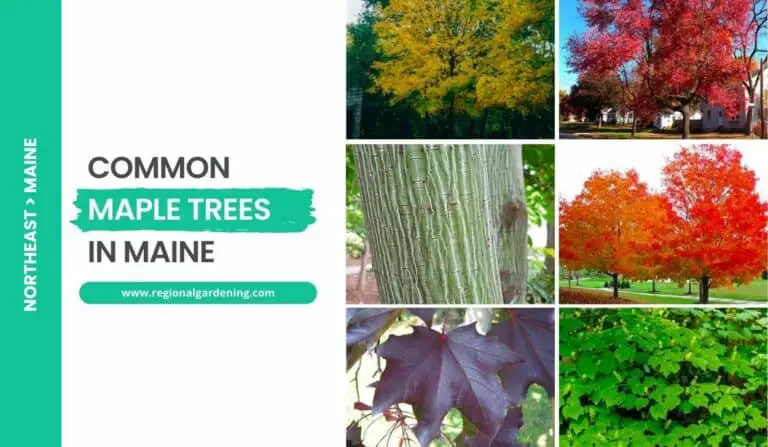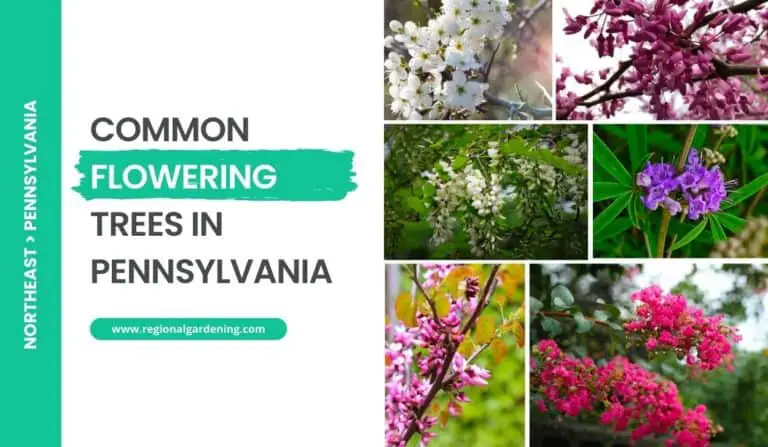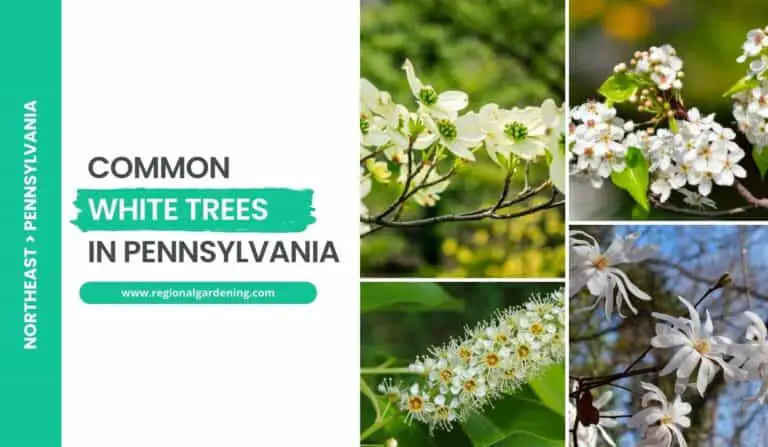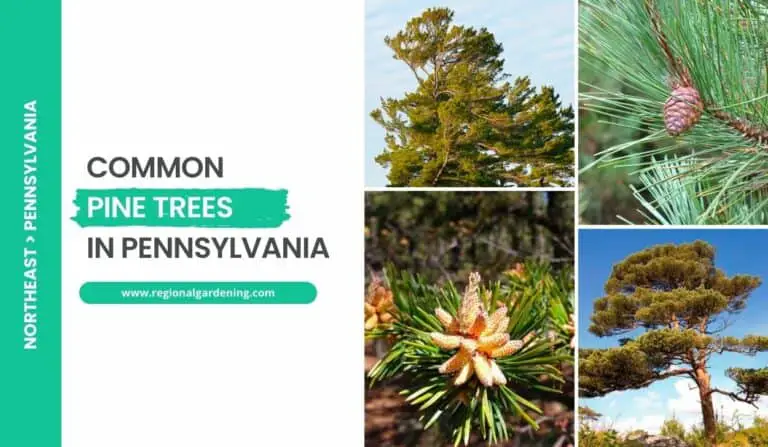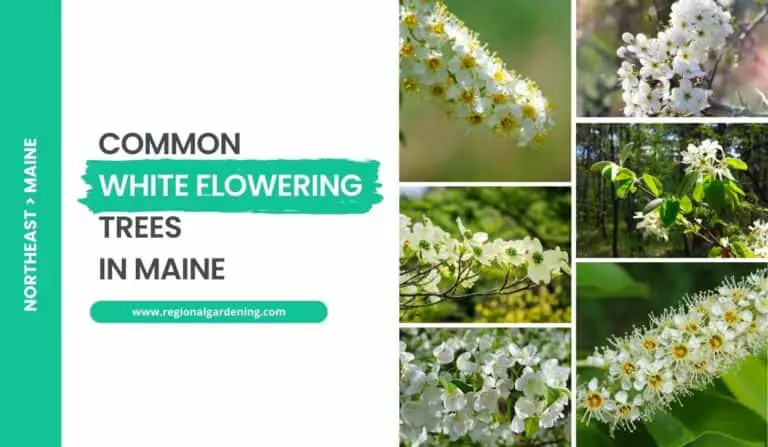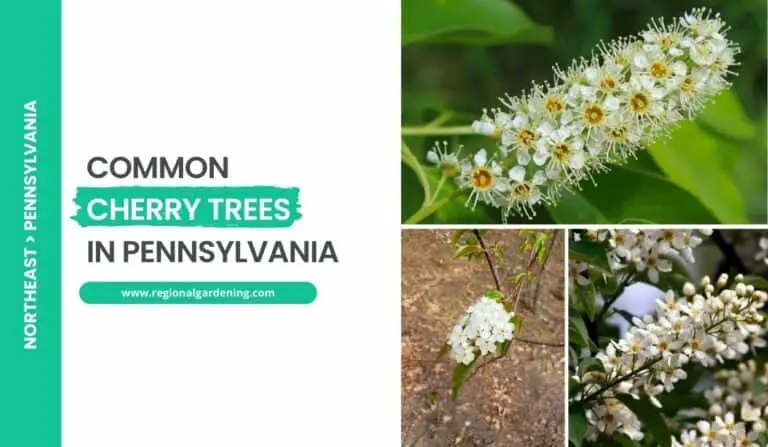5 Types Of Spruce Trees In Maine (With Photos)
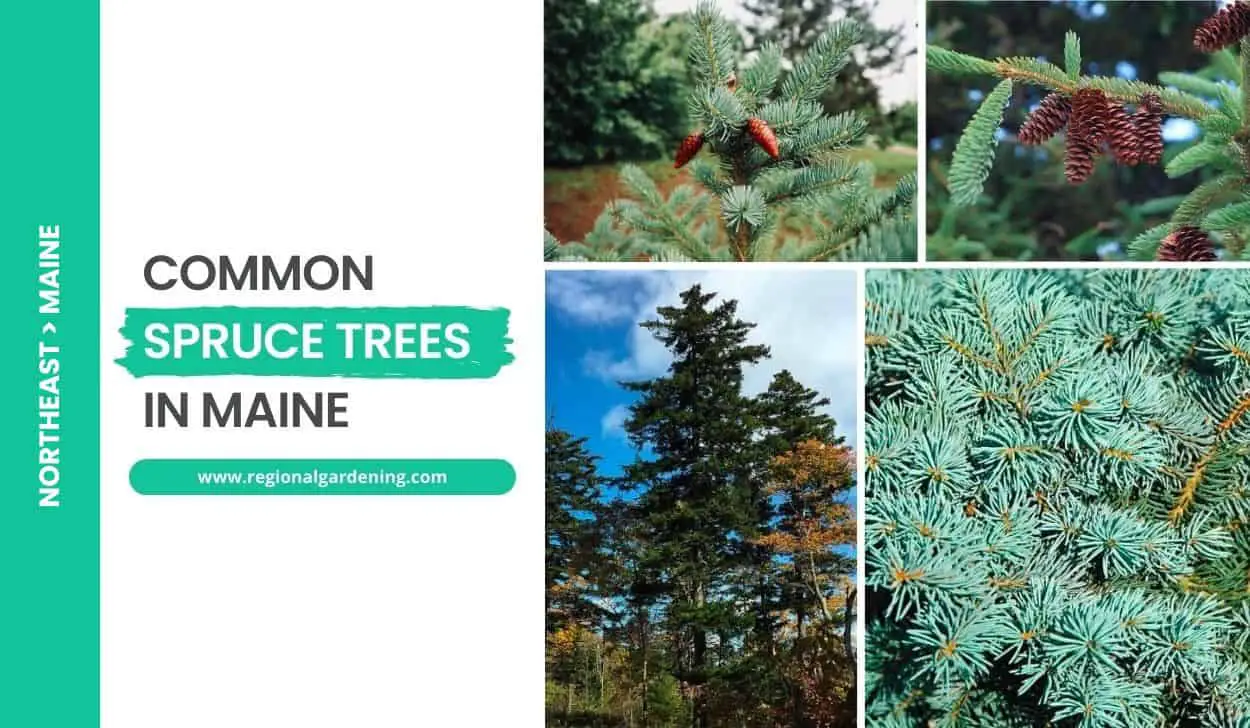
The majestic presence of spruce trees adorns Maine’s rugged and picturesque wilderness.
These magnificent evergreens with needle-like foliage are not only a signature sight in the state, but they also serve several functions. Spruce trees play an important role in Maine’s ecosystem and economy, from providing wildlife habitat to providing timber and Christmas trees.
In this article, we will look at five common spruce trees found in Maine, delving into their unique characteristics, uses, and the wonders they bring to the state’s breathtaking landscapes.
So, let’s get prepared to be immersed in the beauty and resilience of iconic spruce trees in Maine.
1. Black Spruce
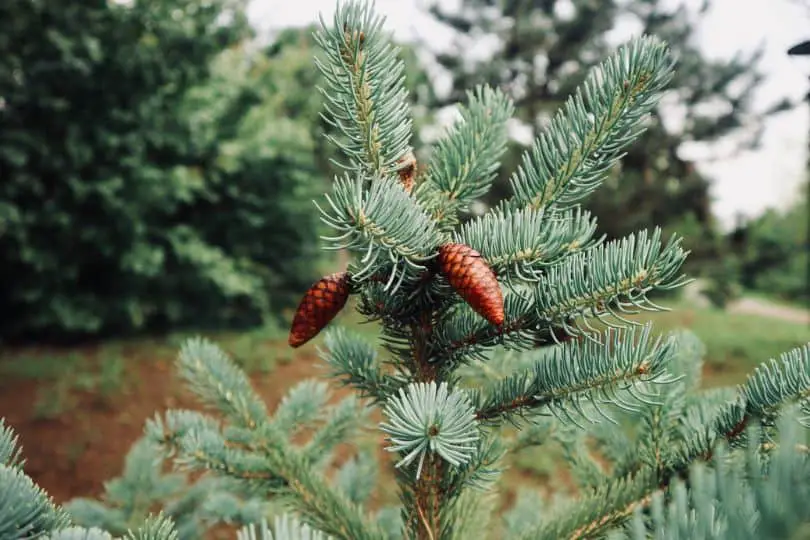
- Scientific Name: Picea mariana (Mill.) B. S. P.
- Common Name(s): Black spruce
- Mature Height: 70-90 feet (21-27 meters)
- Native Region: North America
- Flowers: No flowers
- Fruit: Cones that are ½ – 1 ½ inches long, ovoid, and become nearly spherical when open
- Uses: Manufacture of pulp, framing and construction lumber, planking, Christmas trees, and spruce beer is made by boiling the branches.
The most frequent spruce tree in Maine landscapes is black spruce, technically known as Picea mariana. Except for Sagadahoc, it can be viewed in every country. This tree grows well in cool upland soils, but it is more usually found along streams, on marsh edges, and in sphagnum bogs. Black spruce can reach a mature height of 70-90 feet and a diameter of 6-18 inches in its native region of North America.
The physical qualities of black spruce are distinct. Its short, pendulous branches tend to bend up at the ends, resulting in an open, uneven crown. Lower branches frequently touch the ground and can even generate new trees due to natural stacking. The bark on the trunk is grayish-brown and splits into tiny scales.
The leaves are dull blue-green in hue and range in length from 14 to 112 inches. They have a blunt point, are flexible, and are soft to the touch. When open, the cones are ovoid, measuring 12 – 12 inches long, and become nearly spherical. The cone scales have toothed borders and are rigid. Surprisingly, the cones typically remain on the trees for many years.
Black spruce is often used in Maine landscapes for a variety of uses. Its soft and light wood is ideal for pulp, framing construction lumber, and planking. Black spruce is another popular Christmas tree species. Furthermore, the spruce tree’s branches can be utilized to manufacture spruce beer by boiling them.
It is critical to ensure that black spruce trees in Maine landscapes are planted in well-drained soils and receive appropriate moisture. In a suitable location, black spruce grows quickly, yet it can survive cooler and wetter circumstances better than many other trees. Regular pruning may be required to keep an open crown structure.
2. Red Spruce
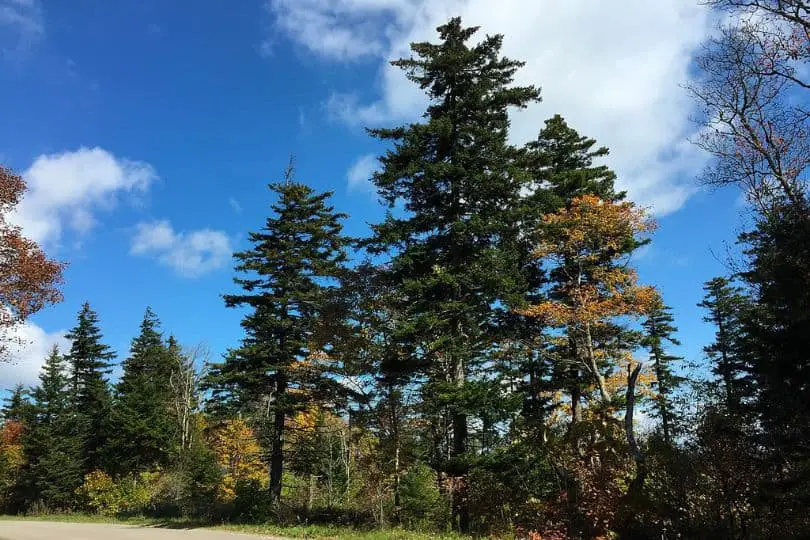
- Scientific Name: Picea rubens Sarg.
- Common Name(s): Red Spruce
- Mature Height: 60 – 80 feet (18 – 24 meters)
- Native Region: Maine, Northeastern United States
- Flowers: No Flowers
- Fruit: Oblong cones, 1 ½ – 2 inches long, reddish brown when ripe
- Uses: Building lumber, paper pulp, musical instruments, Christmas trees, spruce gum
Picea rubens Sarg., also known as red spruce, is a common tree seen in Maine settings. It grows best on well-drained, rocky upland soils, especially on the north side of mountain slopes, where it frequently becomes the dominant species.
In its early stages, this tree has a conical and narrow head with spreading branches. It can reach a height of 60 to 80 feet and a diameter of 1 to 2 feet as it ages, occasionally exceeding these measurements.
The bark of mature Red Spruce trees is thick and irregularly shaped, with thin reddish-brown scales. The leaves are dark green, sometimes with a yellow tinge, and glossy. They are around 12 inches long, sharply pointed, rigid, and prickly to the touch.
Red Spruce cones are rectangular and often measure 1 12 to 2 inches long. When ripe, the cones are reddish-brown in hue and lustrous. The cone scales are rigid, comparable to black spruce, but lack prominent notches. The cones completely disappear by the following summer after falling from the trees in autumn or early winter.
Red Spruce twigs have hairs, but none of them have a gland at the tip, which distinguishes them from black spruce. This tree’s inner bark is reddish-brown.
Red Spruce wood is highly appreciated for a variety of applications. It is very useful in the manufacturing of building lumber like as joists, sills, rafters, and heavy construction timbers. The wood is also widely utilized in the production of paper pulp.
Red Spruce is also used for weir poles, piling, and Christmas trees. It is particularly appreciated for its use in musical instruments, primarily sounding boards. Spruce gum, extracted from Red Spruce trees, is another important commodity made from this species.
Red Spruce is a shade-tolerant tree that flourishes in the understory of mixed stands in Maine environments. It thrives on well-drained, rocky soils, making it an excellent choice for gardens and landscapes in these conditions.
It is critical to allow enough room for its mature height and spread. This tree can tolerate harsher temperatures and is well-suited to Maine’s hard winters. Regular maintenance, such as pest and disease monitoring and adequate watering during dry months, will assist in guaranteeing the health and longevity of Red Spruce in Maine landscapes.
3. Blue Spruce
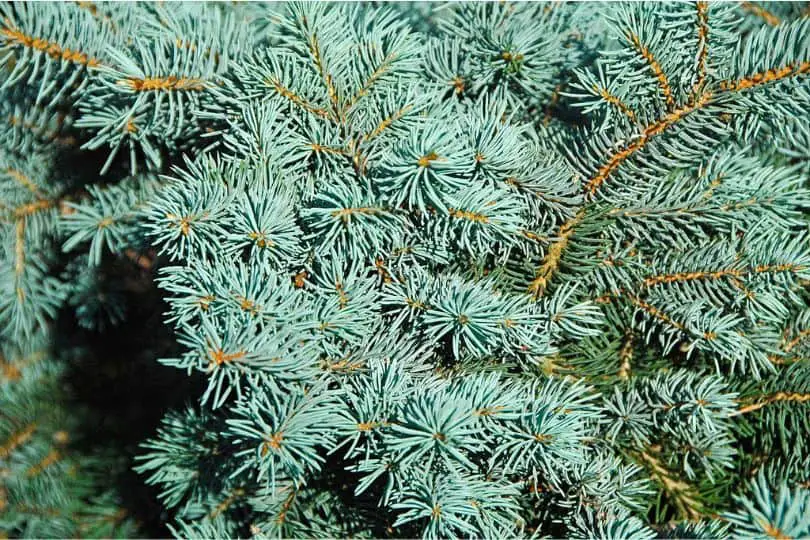
- Scientific Name: Picea pungens Engelm.
- Common Name(s): Blue Spruce
- Mature Height: 50-75 feet (15-23 meters)
- Native Region: Rocky Mountain region of North America
- Flowers: No Flowers
- Fruit: Cones are oblong, 2 ½-¼ inches long, with thin, flexible, notched scales.
- Uses: Blue Spruce is commonly used as a decorative tree in landscapes for its striking blue foliage and attractive shape.
Blue spruce, scientifically known as Picea pungens Engelm., is a native tree of North America’s Rocky Mountains. Because of its distinct and bright qualities, it is commonly planted as a decorative tree throughout the Eastern area, including Maine.
Blue spruce leaves vary in color from silvery-blue to blue-green, with the intensity of blue changing across individual specimens. The tree’s leaves are about an inch long, rigid, highly sharp-pointed, and have a strongly incurved form.
The blue spruce grows to a mature height of 50-75 feet (15-23 meters) in appearance. The tree has a symmetrical conical shape with branches that reach to the ground. Blue spruce cones are rectangular, ranging around 2 12 to 14 inches long, and feature thin, flexible, and notched scales.
Blue spruce is adaptable to a wide range of growing circumstances and can survive a wide range of settings. Because of its versatility, it has become a favorite decorative species in Maine landscapes. The tree prefers full sun but may take moderate shade. It requires well-drained soil and, once established, can endure drought times. Watering should be done regularly, especially during dry seasons, to ensure good development.
Blue spruce is frequently planted as a single specimen on lawns or in landscape effects in Maine, where its leaf’s color and symmetrical shape serve as the main point. The vivid blue foliage contrasts beautifully with other plants in the landscape, giving visual interest.
Blue spruce can also be utilized to construct privacy screens or windbreaks in open locations. It is visually appealing all year and acts as a habitat for birds and small creatures.
4. White Spruce
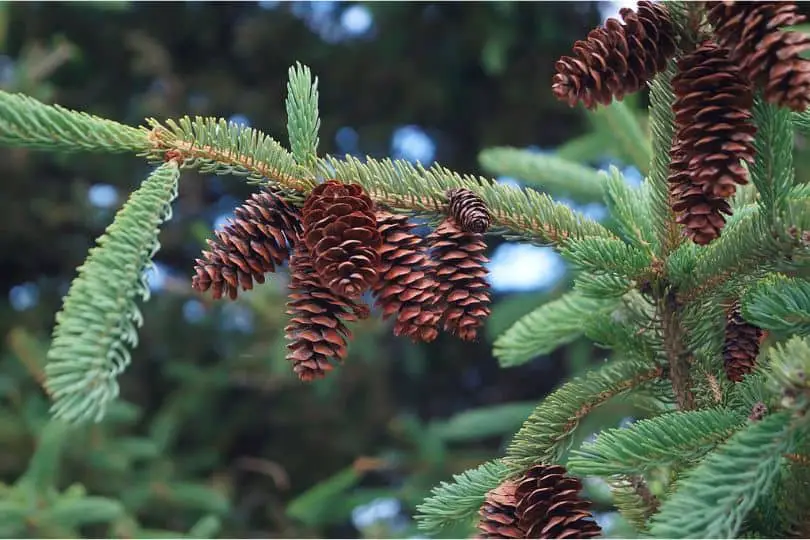
- Scientific Name: Picea glauca (Moench) Voss
- Common Name(s): White Spruce, Cat Spruce
- Mature Height: 60-90 feet (18-27 meters)
- Native Region: Statewide in Maine, except for Sagadahoc and York counties
- Flowers: No Flowers
- Fruit: Slender, cylindrical cones, about two inches long, pale brown and shiny when ripe
- Uses: Pulp, paddles, oars, piano sounding boards, dimension lumber, limited amounts for Christmas trees
White spruce, Picea glauca (Moench) Voss, is a common tree found throughout Maine, except for Sagadahoc and York counties. It is not as common as red spruce, although it is found throughout the state. White spruce grows from the shore to the tree line in the mountains, and it is also prevalent in old meadows or cleared land. It favors open spaces and will not develop as an understory tree or tolerate shade.
The full height of this spruce tree is 60-90 feet (18-27 meters) with a diameter of up to two feet. Long and thick branches are densely covered with robust, inflexible lateral branches. The tree’s general shape is fairly uneven, having a large base. Older trees have light gray, plate-like scales that are thin, uneven, and brownish.
The bark of younger trees is smooth and light gray. When young, the leaves of white spruce are pale blue-green, maturing to a dark blue-green. The lower half of the branches frequently contain leaves that are twisted upward, creating a distinguishing feature of this species. The leaves have a distinct and distinctive odor that separates them from other spruce species.
White spruce has slender, cylindrical cones that are about two inches long. When ripe, the cones are pale brown and lustrous, and they ripen in August and September. They frequently fall from the tree within the first year. Because the cone scales are thin and flexible, they give easily when clutched in the hand. White spruce twigs are hairless, and the inner bark is silvery and glistening.
In terms of applications, white spruce wood is quite light, and soft, and finishes well. It is moderately sturdy and is used to make pulp, paddles, oars, piano sounding boards, and dimension lumber. White spruce is also used as a Christmas tree in limited quantities.
Additionally, both white and black spruce produce long, strong, and malleable roots that indigenous peoples have historically used to bind together pieces of birch bark for canoes and other purposes.
White spruce thrives in wide, sunny settings and prefers well-drained soil in Maine landscapes. It is critical to maintain adequate soil moisture levels, especially during dry periods. Watering regularly is essential during the establishment period. Mulching around the base of the tree aids in moisture conservation and weed control.
Pruning is not usually required, however dead or damaged branches can be removed. White spruce is a low-maintenance tree that is resistant to pests and diseases common in Maine.
5. Norway Spruce
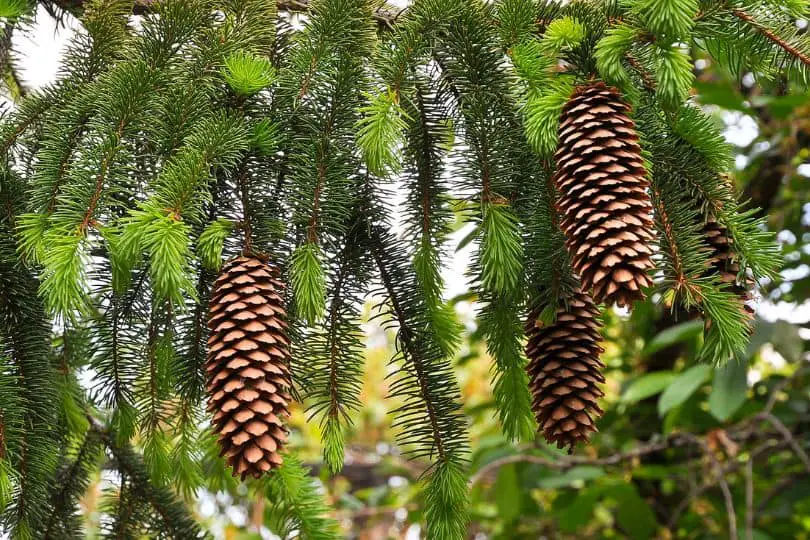
- Scientific Name: Picea abies (L.) Karst.
- Common Name(s): Norway Spruce
- Mature Height: 40-60 feet (12-18 meters)
- Native Region: Europe
- Flowers: No Flowers
- Fruit: Cones are cylindrical, 4-7 inches long with stiff, notched scales.
- Uses: Planted in forest plantations, ornamental trees, pulpwood, and lumber.
Norway spruce, scientifically known as Picea abies, is a tall and magnificent European tree. It has a high economic value in its natural region and is often planted in forest plantations as well as as an ornamental tree. It thrives in Maine landscapes and lends beauty to any environment, even though it rarely reproduces in the wild.
This spruce species grows symmetrically and gracefully, with open-grown trees frequently carrying branches to the ground. The tops of bigger trees’ branches reach upward, and lateral branchlets are long and pendent.
The twigs are smooth and hairless. Norway Spruce is recognized for its quick growth, outpacing all native spruce species in Maine. As a result, it is a popular choice for pulpwood, which is used to manufacture paper and other wood-based products. It is also prized as a decorative tree and is occasionally used for lumber.
The Norway Spruce leaves are about an inch long, sharply pointed, and shiny with a dark green tint. The needles of the Norway Spruce do not bend upward on the twigs like those of the white spruce. This distinguishing characteristic adds to its visual charm. The tree produces cylindrical cones with rigid, notched scales that range in length from 4 to 7 inches. The cones mature between September and November, however, they can be picked between September and April.
Norway Spruce thrives in a variety of environments in Maine landscapes. It may grow in a variety of soil types, including loamy, sandy, and acidic soils. This makes it appropriate for both residential yards and parks, as well as larger forested areas.
When planting a Norway Spruce, make sure to leave enough room for it to grow, since it can reach mature heights of 40 to 60 feet (12 to 18 meters). Watering regularly in the first few years after planting can help with establishment and overall health.
Aside from its aesthetic value, the Norway Spruce has a wide range of applications. As previously said, it is widely farmed for its pulpwood, which serves as an important raw material for the paper industry. It can also be converted into lumber for use in various construction projects.
Furthermore, the Norway Spruce is a popular ornamental tree, bringing a touch of elegance to landscapes, especially during the holiday season. When planted in rows or hedges, its dense foliage provides excellent windbreak and privacy screening.
Similar Articles
- Common Pine Trees In Maine
- Common Oak Trees In Maine
- Common Ash Trees In Maine
- Common Birch Trees In Maine
- Common Maple Trees In Maine
- Common Cedar Trees In Maine
- Native Aspen Trees In Maine
- Native Hickory Trees In Maine
- Common Cherry Trees In Maine
- White Flowering Trees In Maine
Common Spruce Trees In Maine – Sources
The Regional Gardening team makes sure that the information in our articles is accurate by only using sources that are known to be trustworthy. Some of these sources are peer-reviewed journals from government agencies, well-known universities, and scientific research organizations.
- Forest Trees of Maine, Maine Department Of Agriculture, Conservation & Forestry
- Identify Maine’s Common Foliage Trees, Maine Foilage
- Plants for the Maine Landscape, University Of Maine Cooperative Extension.
- Gardening to Conserve Maine’s Native Landscape, University Of Maine Cooperative Extension


